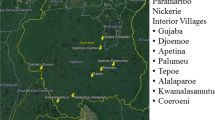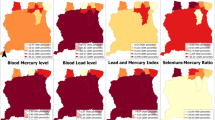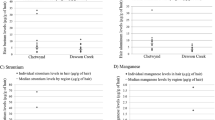Abstract
Human exposure to mercury is a leading public health problem. Artisanal and small-scale gold mining (ASGM) is a major source of global mercury emissions. Although occupational mercury exposure to miners (via mercury vapor inhalation) is known, chronic mercury exposure to nearby residents that are not miners (via mercury-contaminated fish consumption) is poorly characterized. We conducted a population-based mercury exposure assessment in 23 communities (19 rural, 4 urban) around the Amarakaeri Communal Reserve, which is bordered on the east by heavy ASGM activity. We measured total mercury in hair (N = 2083) and blood (N = 476) from March-June 2015 and performed follow-up measurements (N = 723 hair and N = 290 blood) from February-April 2016. Mercury exposure risk was highest in communities classified as indigenous, or native, regardless of proximity to mining activity. Residence in a native community (vs. non-native) was associated with mercury levels 1.9 times higher in hair (median native 3.5 ppm vs. median non-native 1.4 ppm total mercury) and 1.6 times higher in blood (median native 7.4 ng/mL vs median non-native 3.2 ng/mL total mercury). Unexpectedly, proximity to mining was not associated with exposure risk. These findings challenge common assumptions about mercury exposure patterns and emphasize the importance of population-representative studies to identify high risk sub-populations.
This is a preview of subscription content, access via your institution
Access options
Subscribe to this journal
Receive 6 print issues and online access
$259.00 per year
only $43.17 per issue
Buy this article
- Purchase on Springer Link
- Instant access to full article PDF
Prices may be subject to local taxes which are calculated during checkout




Similar content being viewed by others
Data availability
Data on legal mining concessions leased by the Peruvian government are available from the Ministry of Energy and Mining of Peru (http://www.minem.gob.pe/). Data on recent mining activity are available on request from Matthew Finer of the Monitoring of the Andean Amazon Project (maaproject.org). Mercury exposure and epidemiological datasets generated during and/or analyzed during the current study are not publicly available, due to restrictions for protection of human subjects, but are available from the corresponding author on reasonable request.
References
Landrigan PJ, Fuller R, Acosta NJR, Adeyi O, Arnold R, Basu NN, et al. The Lancet Commission on pollution and health. Lancet. 2018;391:462–513.
Steckling N, Tobollik M, Plass D, Hornberg C, Ericson B, Fuller R, et al. Global burden of disease of mercury used in artisanal small-scale gold mining. Ann Glob Health. 2017;83:234–47.
Bank MS, Vignati DA, Vigon B. United Nations Environment Programme’s Global Mercury Partnership: science for successful implementation of the Minamata Convention. Environ Toxicol Chem. 2014;33:1199–201.
National Research Council. Toxicological effects of methylmercury. Washington, DC: The National Academies Press; 2000.
Agency for Toxic Substances and Disease Registry (ATSDR). Toxicological profile for mercury. Atlanta, Georgia: U.S. Department of Health and Human Services; 1999.
Steckling N, Devleesschauwer B, Winkelnkemper J, Fischer F, Ericson B, Kramer A, et al. Disability weights for chronic mercury intoxication resulting from gold mining activities: results from an online pairwise comparisons survey. Int J Environ Res Public Health. 2017;14:E57.
Ha E, Basu N, Bose-O’Reilly S, Dorea JG, McSorley E, Sakamoto M, et al. Current progress on understanding the impact of mercury on human health. Environ Res. 2017;152:419–33.
Ashe K. Elevated mercury concentrations in humans of Madre de Dios, Peru. PLoS One. 2012;7:e33305.
Yard EE, Horton J, Schier JG, Caldwell K, Sanchez C, Lewis L, et al. Mercury exposure among artisanal gold miners in Madre de Dios, Peru: a cross-sectional study. J Med Toxicol. 2012;8:441–8.
Langeland AL, Hardin RD, Neitzel RL. Mercury levels in human hair and farmed fish near artisanal and small-scale gold mining communities in the Madre de Dios River Basin, Peru. Int J Environ Res Public Health. 2017;14:E302.
Gibb H, O’Leary KG. Mercury exposure and health impacts among individuals in the artisanal and small-scale gold mining community: a comprehensive review. Environ Health Perspect. 2014;122:667–72.
Fraser B. Peruvian gold rush threatens health and the environment. Environ Sci Technol. 2009;43:7162–4.
INEI. Peru: Encuesta Demografica de Salud Familiar (ENDES) 3014. Peru: Instituto Nacional de Estadistica e Informatica Lima; 2015.
United States Environmental Protection Agency. Method 7473 (SW-846): mercury is solids and solutions by thermal decomposition, amalgamation, and atomic absorption spectrophotometry, Revision 0. 1998.
Monastero RN, Karimi R, Nyland JF, Harrington J, Levine K, Meliker JR. Mercury exposure, serum antinuclear antibodies, and serum cytokine levels in the Long Island Study of Seafood Consumption: a cross-sectional study in NY, USA. Environ Res. 2017;156:334–40.
Kolenikov SAG. Socioeconomic status measurement with discrete proxy variables: Is principal component analysis a reliable answer? Rev Income Wealth. 2009;55:128–65.
Finer MOT, Novoa S. Gold Mining Deforests 32,000 Acres in southern Peruvian Amazon from 2013 to 2016. MAAP:50. Monitoring the Andean Amazon Project. 2016.
Asner GP, Llactayo W, Tupayachi R, Luna ER. Elevated rates of gold mining in the Amazon revealed through high-resolution monitoring. Proc Natl Acad Sci USA. 2013;110:18454–9.
Hansen MC, Krylov A, Tyukavina A, Potapov PV, Turubanova S, Zutta B, et al. Humid tropical forest disturbance alerts using Landsat data. Environ Res Lett. 2016;11:034008.
Hansen MC, Potapov PV, Moore R, Hancher M, Turubanova SA, Tyukavina A, et al. High-resolution global maps of 21st-century forest cover change. Science 2013;342:850–3.
JECFA. Summary and conclusions of the 67th Joint FAO/WHO Expert Committee on Food Additives. Geneva, Switzerland: World Health Organization, International Programme on Chemical Safety; 2004.
Asner GP, Tupayachi R. Accelerated losses of protected forests from gold mining in the Peruvian Amazon. Environ Res Lett. 2016;12:094004.
Ingram V, TJC, Schure J, Nkamgnia E, Tadjuidje MH. Where artisanal mines and forest meet: socio-economic and environmental impacts in the Congo Basin. Nat Resour Forum. 2011;35:304–20.
Hilson G. Small-scale mining and its socio-economic impact in developing countries. Nat Resour Forum. 2002;26:3–13.
The United Nations Environment Programme. UNEP Global Mercury Assessment 2013: sources, emissions, releases and environmental transport. Geneva, Switzerland: Branch UC; 2013.
Diringer SE, Feingold BJ, Ortiz EJ, Gallis JA, Araujo-Flores JM, Berky A, et al. River transport of mercury from artisanal and small-scale gold mining and risks for dietary mercury exposure in Madre de Dios, Peru. Environ Sci Process Impacts. 2015;17:478–87.
Wyatt L, Ortiz EJ, Feingold B, Berky A, Diringer S, Morales AM, et al. Spatial, temporal, and dietary variables associated with elevated mercury exposure in peruvian riverine communities upstream and downstream of artisanal and small-scale gold mining. Int J Environ Res Public Health. 2017;14:E1582.
Diringer SE, Berky AJ, Marani M, Ortiz EJ, Karatum O, Plata DL, et al. Deforestation due to artisanal and small-scale gold minng exacerbates soil and mercury mobilization in Madre de Dios, Peru. Environ. Sci. Technol. 2020;54:286–96.
Klotz K, Goen T. Human biomonitoring of lead exposure. Met Ions Life Sci. 2017;17:99–122. https://doi.org/10.1515/9783110434330-006.
Afridi HI, Talpur FN, Kazi TG, Brabazon D. Assessment of toxic elements in the samples of different cigarettes and their effect on the essential elemental status in the biological samples of Irish hypertensive consumers. J Hum Hypertens. 2015;29:309–15.
Yasutake A, Hachiya N. Accumulation of inorganic mercury in hair of rats exposed to methylmercury or mercuric chloride. Tohoku J Exp Med. 2006;210:301–6.
Cernichiari E, Myers GJ, Ballatori N, Zareba G, Vyas J, Clarkson T. The biological monitoring of prenatal exposure to methylmercury. Neurotoxicology 2007;28:1015–22.
The United Nations Environment Programme (UNEP). The Minamata Convention on Mercury. 2013.
Acknowledgements
The authors acknowledge local field workers and Jean-Pierre Muro of MEDLAB-Peru for assistance in data collection, as well as support from the Madre de Dios Regional Health Directorate (DIRESA), particularly Drs Emperatriz Morales, Elvis Rojas and Fernando Mendieta. Support for this study was provided by the Inter-American Institute for Global Change Research (CRN 3034), Bass Connections at Duke University, and Hunt Oil Peru LLC (HOEP-QEHSS-140003).
Funding
This study was funded by the Inter-American Institute for Global Change Research (CRN 3034), Bass Connections at Duke University, Hunt Oil Peru LLC (HOEP-QEHSS-140003), and the Duke University Superfund Research Center (P42ES010356.) The study funders had no roles in study design, data collection, data analysis, data interpretation, or manuscript preparation. The corresponding author had full access to all study data and had final responsibility for the decision to submit for publication.
Author information
Authors and Affiliations
Contributions
CW, WKP, EO and HH-K conceived research questions. CW oversaw data analysis, created figures (except Fig. 1) and tables, and wrote the manuscript. JG analyzed data. AJB created Fig. 1. EO, AMM, and AJB coordinated data collection in the field. SD created mining proximity variables. JH oversaw total blood mercury measurements at Research Triangle Institute. PB and JH-G measured total hair mercury in the laboratory of HH-K. WKP, HH-K, EO, AJB, and AMM designed the study. WKP obtained funding and oversaw the study.
Corresponding author
Ethics declarations
Conflict of interest
The authors declare that they have no conflict of interest.
Additional information
Publisher’s note Springer Nature remains neutral with regard to jurisdictional claims in published maps and institutional affiliations.
Supplementary information
Rights and permissions
About this article
Cite this article
Weinhouse, C., Gallis, J.A., Ortiz, E. et al. A population-based mercury exposure assessment near an artisanal and small-scale gold mining site in the Peruvian Amazon. J Expo Sci Environ Epidemiol 31, 126–136 (2021). https://doi.org/10.1038/s41370-020-0234-2
Received:
Revised:
Accepted:
Published:
Issue Date:
DOI: https://doi.org/10.1038/s41370-020-0234-2
This article is cited by
-
Emerging mercury and methylmercury contamination from new artisanal and small-scale gold mining along the Nile Valley, Egypt
Environmental Science and Pollution Research (2023)
-
Identifying contamination of heavy metals in soils of Peruvian Amazon plain: use of multivariate statistical techniques
Environmental Monitoring and Assessment (2022)
-
Emerging mercury mitigation solutions for artisanal small-scale gold mining communities evaluated through a multicriteria decision analysis approach
Environment Systems and Decisions (2021)



